    |
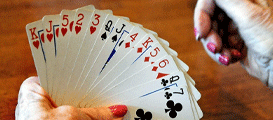    |
    |
Liar’s poker |
Bridge |
Basset |
|
Liar’s poker is an American bar game that combines statistical reasoning with bluffing, and is played with the eight digits of the serial number on U.S. dollar bills. The digits are usually ranked with the 1 as “ace” as the highest value, followed by 0 as “10”, down to 2 as the lowest. Each player holds one bill, unseen by the other players. The objective is to guess how often a particular digit appears among all the bills held by all the players. Each guess or bid must be higher in value or quantity than the previous bid. The round ends when all the other players challenge a bid.
|
Contract bridge, or simply bridge, is a trick-taking card game using a standard 52-card deck. It is played by four players in two competing partnerships,with partners sitting opposite each other around a table.Millions of people play bridge worldwide in clubs, tournaments, online and with friends at home, making it one of the world’s most popular card games, particularly among seniors. The World Bridge Federation (WBF) is the governing body for international competitive bridge, with numerous other bodies governing bridge at the regional level. |
Basset (French bassette, from the Italian bassetta), also known as barbacole and hocca, is a gambling card game that was considered one of the most polite. It was intended for persons of the highest rank because of the great losses or gains that might be accrued by players. The play in Basset resulted in, basically, a lottery. A player might occasionally win, but the big winner was the dealer (banker). The dealer had a number of privileges under the rules, including having the sole disposal of the first and last card; this gave him or her a significant edge. |
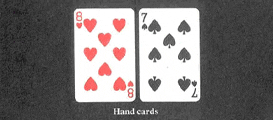    |
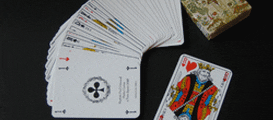    |
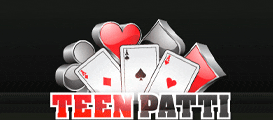    |
Lansquenet |
Piquet |
Teen patti |
|
Lansquenet is a card game, named after the French spelling of the German word Landsknecht (‘servant of the land or country’), which refers to 15th- and 16th-century German mercenary foot soldiers; The lansquenet drum is a type of field drum used by these soldiers. The dealer or banker stakes a certain sum, and this must be met by the nearest to the dealer first, and so on. |
Piquet is played with a 32-card deck, normally referred to as a piquet deck. The deck comprises the 7s through to 10s, the face cards, and the aces in each suit, and can be created by removing all 2–6 values from a 52-card poker deck. Each game consists of a partie of six deals (partie meaning match in French). The player scoring the most points wins (see the scoring section for further details). |
Teen patti (also known as flash or flush) is a gambling card game that originated in the Indian Subcontinent. The game, which is actually a simplified version of poker,is popular throughout South Asia. Boats out of India call it “flush” to escape any legal negativity surrounding the game where it is played legally. |
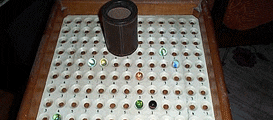    |
||
The Razzle |
|
|
|
Razzle is a game sometimes presented on carnival midways and historically, in the casinos of Havana, Cuba.The game is also known as Razzle-Dazzle. This generic name is seldom known to players, as it is generally presented as Football, Ten Points Win, Baseball, Mo-Co, Indian Poker, Cajun Bingo or other name selected to generate interest for the locals. The nature of the game makes it a particular money-maker for dishonest carnies. |
|
|
    |
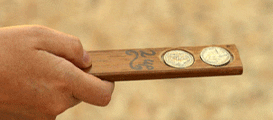    |
|
Head and Tail |
Two-up |
|
|
Coin flipping, coin tossing, or heads or tails is the practice of throwing a coin in the air and checking which side is showing when it lands to choose between two alternatives, sometimes to resolve a dispute between two parties. It is a form of sortition which inherently has only two possible and equally likely outcomes. |
Two-up is a traditional Australian gambling game, involving a designated “spinner” throwing two coins or pennies into the air. Players bet on whether the coins will fall with both heads (obverse) up, both tails (reverse) up, or with one coin a head and one a tail (known as “odds”). It is traditionally played on Anzac Day in pubs and clubs throughout Australia, in part to mark a shared experience with Diggers through the ages. |
|
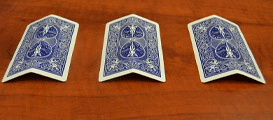    |
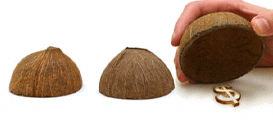    |
|
Three-card Monte |
Shell game |
|
|
Three-card Monte – also known as find the lady and three-card trick – is a confidence game in which the victim, or “mark”, is tricked into betting a sum of money, on the assumption that they can find the “money card” among three face-down playing cards. It is the same as the shell game except that cards are used instead of shells.[1] |
The shell game (also known as thimblerig, three shells and a pea, the old army game) is portrayed as a gambling game, but in reality, when a wager for money is made, it is almost always a confidence trick used to perpetrate fraud. In confidence trick slang, this swindle is referred to as a short-con because it is quick and easy to pull off. |
|
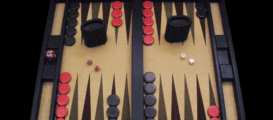    |
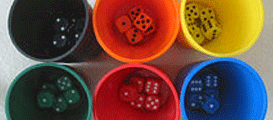    |
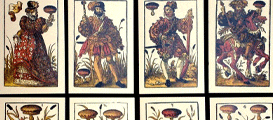    |
Backgammon |
Liar’s dice |
Passe-dix |
|
Backgammon is one of the oldest board games known. It is a two player game where each player has fifteen pieces (checkers) which move between twenty-four triangles (points) according to the roll of two dice. The objective of the game is to be first to bear off, i.e. move all fifteen checkers off the board. Backgammon is a member of the tables family, one of the oldest classes of board games.
|
Liar’s dice is a class of dice games for two or more players requiring the ability to deceive and detect an opponent’s deception. In “common hand” liar’s dice games, each player has a set of dice, all players roll once, and the bids relate to the dice each player can see (their hand) plus all the concealed dice (the other players’ hands). In “individual hand” games, there is one set of dice which is passed from player to player. |
Passe-dix, also called passage in English, is a game of chance using dice. It was described by Charles Cotton in The Compleat Gamester (1674) thus:”Passage is a Game at dice to be played at but by two, and it is performed with three Dice. The Caster throws continually until he hath thrown Dubblets under ten, and then he is out and loseth; or Dubblets above ten, and then he passeth and wins.” |
    |
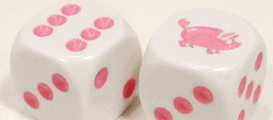    |
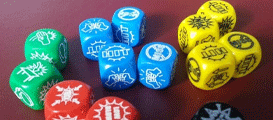    |
Hazard (game) |
Pig (dice game) |
Mexico (game) |
|
Hazard is an early English game played with two dice; it was mentioned in Geoffrey Chaucer’s Canterbury Tales in the 14th century. Despite its complicated rules, hazard was very popular in the 17th and 18th centuries and was often played for money. At Crockford’s Club in London, hazard was especially popular. In the 19th century, the game craps developed from hazard through a simplification of the rules. Craps is now very popular in North America but neither game remains popular amongst the rest of the world. |
Pig is a simple dice game first described in print by John Scarne in 1945. As with many games of folk origin, Pig is played with many rule variations. Commercial variants of Pig include Pass the Pigs, Pig Dice, and Skunk. Pig is commonly used by mathematics teachers to teach probability concepts. Pig is one of a family of dice games described by Reiner Knizia as “jeopardy dice games”. For jeopardy dice games, the dominant type of decision is whether or not to jeopardize previous gains by rolling for potential greater gains. |
Mexico is an elimination-style dice game, in which several players agree to play a set number of rounds. After each round, one player is eliminated. When all players but one have been eliminated, the remaining player wins the game. Owing to its extremely simple play-structure, it is generally pursued as a method of gambling, whereby the final remaining player wins the amount of money wagered by each person who was eliminated in earlier rounds. A variant of the drinking game liar’s dice known as Mexican or Mia uses similar dice rolls, but has very different game mechanics. |
The Author
The Author